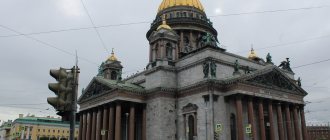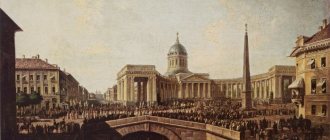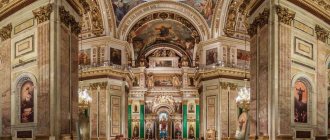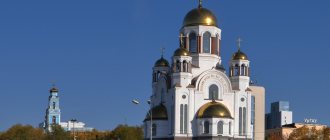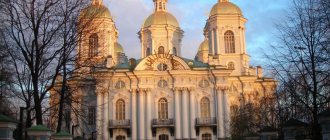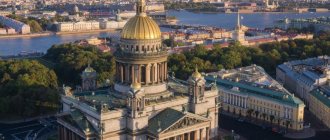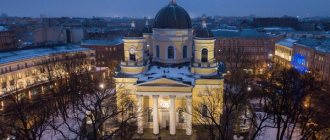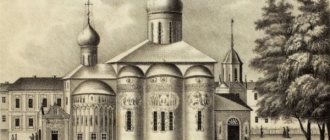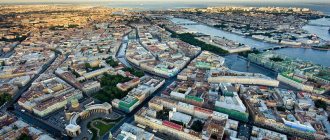| Trinity-Izmailovsky Cathedral in St. Petersburg, 2011. Photo by Nikolai Pechurin from the site sobory.ru |
St. Petersburg Cathedral in the name of the Life-Giving Trinity, Life Guards of the Izmailovsky Regiment
of the St. Petersburg Diocese
- Thrones: Life-Giving Trinity (main), John the Warrior, Mary Magdalene (altar)
- Address: Russia, 198005, St. Petersburg, Izmailovsky pr., 7a
- Official site:
- On the map: Yandex.Map, Google map
The fourth high-rise architectural dominant of the city, the cathedral is visible 20 km away.
Directions to the cathedral - to the Tekhnologichesky Institut metro station; bus break 39e; trolleybuses 8, 3; by trams 28, 34, 90. A wooden church in the name of the Life-Giving Trinity was erected on this site in 1754-1756. The church was damaged in the flood of 1824.
In place of the previous temple, it was decided to build the majestic Izmailovsky Cathedral in the same place. The architect was Vasily Stasov. The cathedral was built in 1828-1835. The construction of the cathedral for the Izmailovsky Regiment became the largest construction project in St. Petersburg in the second quarter of the 19th century. Consecration followed on May 25, 1835. Trinity Cathedral has become the decoration of St. Petersburg, a unique military-church ensemble, one of the tallest buildings in the city.
A tragic page in the life of the cathedral is connected with the case of the “counter-revolutionary group of the Izmailovsky Life Guards Regiment” in 1930-1931. The case was directed against former tsarist officers who continued to communicate with each other and attend Trinity Cathedral, some playing an active role in the life of the parish. As a result, a group of parishioners were shot and sent to camps.
Then the Bolsheviks decided to destroy the cathedral itself. In 1932, the Presidium of the Leningrad City Council adopted a corresponding resolution. In its place they wanted to build a theater for the workers of the area - from materials left over from the destroyed building. The city authorities were determined, but desperate parishioners turned to the All-Russian Central Executive Committee. After many months of proceedings, the All-Russian Central Executive Committee still left the cathedral in force.
During the closure of the temple in 1932, an unrealized plan was drawn up to locate a crematorium within its walls. For a long time, the building was a warehouse, was not heated and gradually fell into disrepair, despite the thick walls.
Having defended the cathedral from the authorities, the community began repairing the temple - by this time the building already required replacement of wiring, roofing work, restoration of icons, etc. The work lasted about five years. Having made the final decision to close the cathedral and adapt it for other purposes, the authorities, hiding this, energetically forced the community to carry out expensive repairs.
During this tragic time, the cathedral was a cathedral for the only time in its history. This decision was made by Metropolitan Alexy (Simansky) in December 1933. That year he headed the Leningrad diocese, and since the Trinity Cathedral of the Alexander Nevsky Lavra was already closed by that time, the bishop moved the department to the Izmailovsky Cathedral. Vladyka often served here. The Cathedral of the Holy Trinity, as it was then called, had the status of a cathedral until its closure in 1938.
In 1941-1944 the cathedral was damaged by artillery shelling. It was restored twice - in 1952-1956 and 1966-1967. The temple was designated a monument of federal significance and included in the UNESCO list as part of the historical center of St. Petersburg.
In 1990 it was returned to the Leningrad diocese.
On August 25, 2006, as a result of a fire, the central dome and one of the four small domes of the cathedral collapsed. All icons, church utensils and other valuable items stored in the cathedral were removed from the building and placed under police protection. The next morning, while firefighters were still pouring water on the burnt structures, the Divine Liturgy was celebrated on the porch of the church, in the open air. As soon as it became possible to hold services in the cathedral again, they were moved inside. In all subsequent years, despite the ongoing repairs, the Holy Trinity Izmailovsky Cathedral was not closed to parishioners for a day and divine services were performed as usual.
On May 27, 2008, the restored and restored small domes of the cathedral were opened. On October 9 of the same year, a 9-meter cross was installed on the main dome of the cathedral - an exact copy of its predecessor, which had crowned the temple since 1835 and died in a fire. In 2010, large-scale work was carried out to decorate the facades of the cathedral; by this time the restoration of the main altar had been completed. In 2012, restoration of the chapel in honor of Equal-to-the-Apostles Mary Magdalene began. On August 4, 2013, on the day of her memory, the consecration of the restored chapel took place with a priestly rite, which was performed by the rector of the cathedral, Archpriest Gennady Bartov, in the co-service of the cathedral clergy.
Story
On May 13, 1828, the sound of bells announced the construction of a new church in honor of the Holy Life-Giving Trinity
The temple was erected in honor of the Life Guards of the Izmailovsky Regiment. It was formed on September 22, 1730 by decree of Empress Anna Ioannovna. The emperor's military formation did not have its own temple, so the soldiers had to visit other parishes. In the early autumn of 1732, a portable church was brought to St. Petersburg , it was assembled and consecrated. It was a “seasonal church” on the banks of the Fontanka, and with the arrival of cold weather it was dismantled again.
Ten years later, a wooden church was built in its place , but it was small for the large number of parishioners. In 1752, the regiment submitted a petition to Empress Elizabeth Petrovna about the need to build a new church. It was built over two years, but during the flood of 1824 it was damaged and could not be restored.
The decision to build a stone church on the site of a destroyed wooden one was made by Nicholas I. According to his order, the temple premises were supposed to accommodate up to three thousand people. Nicholas I, architect V.P. Stasov and engineer P.P. Bazin took part in the construction. The process moved slowly, as every decision was agreed upon with the emperor.
The first stone of the Holy Trinity Monastery was laid on May 13, 1828 , on the feast of Pentecost. The cathedral an expensive seven years to build and was second in size only to St. Isaac's Cathedral, which was already under construction in St. Petersburg at that time. The cathedral was consecrated on May 25, 1835 on the eve of the Holy Trinity.
The emperor was dissatisfied with the wall paintings and the iconostasis, and twice asked to replace everything, but despite this, the temple seemed very light and spacious. The main shrines of the temple were considered: the image of the Resurrection of Christ, the icon of the Dormition of the Mother of God and the icon of the Mother of God “Joy of All Who Sorrow.”
Despite the fact that the temple was a regimental one, the number of civilian parishioners here increased every year. F. Dostoevsky married A. Snitkina here, and the funeral service of the greatest composer A. G. Rubinstein was also held within its walls.
Soviet time
The fate of the Holy Trinity Izmailovo Cathedral changed dramatically with the advent of Soviet power . The cathedral was turned into a regular parish church , and the regiment to which it belonged was disbanded.
On March 15, 1922, during the Divine Liturgy, with a large crowd of parishioners, the new “reformers” demanded that Archpriest Mikhail Cheltsov hand over the main values of the temple. They received a firm refusal from both the rector of the temple and his parishioners, and fearing “big blood” they retreated.
A month later, Father Mikhail was forced to sign a decree on the transfer of church valuables. The parishioners did their best to collect money and managed to buy out most of the property and the shrine. In total, the Bolsheviks took about 2 kilograms of gold and 300 kilograms of silver from the temple. In 1932, the Bolsheviks decided to completely destroy the cathedral , wiping it off the face of the earth. In its place they planned to build a club for workers. Thanks to numerous requests from parishioners, the All-Russian Central Executive Committee temporarily left the cathedral active. In 1939, the temple building was transferred to the theater. Lensovet for a workshop.
The revival of the cathedral began only in 1990-2000, before which there were periodic reports of theft, acts of vandalism and minor damage over time.
Fire
In 2006, a fire that started on the scaffolding of the Holy Trinity Izmailovo Cathedral destroyed the world's largest dome with a wooden base. The firefighters who arrived at the scene of the tragedy were unable to cope with the flames. The fire rose to a height of more than 100 meters, destroying not only the dome, but also the attic floors. The cause of the fire has not been established. The Divine Liturgy in the church began the next morning , but no longer under the dome of the church, but in the open air.
Interior
The interior of the Izmailovsky Cathedral is laconic and austere. Initially, numerous military artifacts were located within its walls, which is explained by the status of the temple. Due to the predominance of white color in the interior, five light drums and huge windows, there is a lot of light inside, which gives the cathedral solemnity and festivity.
The main elements of the interior are 24 Corinthian columns, which are used to organize the iconostasis, which has a curved shape and forms a single composition with the altar canopy. The painting of the cathedral was done by the serf painter from Yaroslavl T. Medvedev and his son. The icons for the iconostasis were originally painted by venerable academic artists, but later only part of their work was left. They were later supplemented by images made by the self-taught artist N. Maikov. Subsequently, the icons of T. Neff and D. Buzato, which originally stood in St. Isaac's Cathedral, were transferred to the cathedral. Some of the icons moved to the Trinity Cathedral from the old church.
© Official group on VKontakte
Today, the main relic of the Trinity-Izmailovsky Cathedral is the icon of the Holy Trinity from 1406, donated to the revived temple in 2003 with the personal participation of Russian President V.V. Putin. Of interest to believers are the particles of the relics of numerous saints and the Holy Cross stored in the cathedral.
In the basement floor of the temple today there is a “Slavic” hall, painted by artists from the workshop of Vladimir Kulikov. The main decoration of the room is a mosaic depicting the image of the Lord Pantocrator, made by the masters of Ekaterina Ogorodnikova.
Architecture
Izmailovsky Cathedral is a large building with five domes , built in the Empire style. Its height is more than 80 meters. On the facades there are six-column porticoes, in the niches there are figurines of angels made of bronze.
In 1836, marble plaques with the names of officers who died in the battles of Austerlitz, Kulme and Friedland were hung on the walls. The main dome of the cathedral is visible from anywhere in the city at a distance of 20 kilometers.
Tradition says that the blue color of the domes was chosen according to the color of the Izmailovo uniforms
Interior decoration
Inside, the Izmailovsky Cathedral is bright and spacious. The main dome of the cathedral is raised up by four Corinthian columns, it seems to be floating in the air. Turkish banners hung on the walls of the cathedral, reminding of victory in the war with God's help.
In 2005, the Column of Glory was restored in front of the shrine, the basis of which is captured Turkish cannons.
Column of Glory
On the eastern side of the temple is the Column of Glory, built in honor of the victory in the Russian-Turkish war. An unusual monument designed by the architect Grimm was opened in 1886 with the personal participation of Emperor Alexander III.
The 28-meter-high monument is made from 108 cast-iron cannons that came to St. Petersburg as war trophies. Above the guns, placed in 5 tiers, rises an allegorical sculpture of Glory, the goddess Nike, holding a laurel wreath in her hand.
Below, on a granite pedestal, are boards where the main battles of the Russian-Turkish war are listed and the distinguished commanders are named.
In 1930, the monument was removed and melted down, planning to erect a monument to the Decembrists on the site of the memorial, which was never built. Today there is an exact copy of the old Column of Glory, made in 2005.
Fire and recovery
In 2004, a major restoration of the cathedral began, but in August 2006 a big disaster occurred. The scaffolding on the dome caught fire, and the flames spread to the temple. Fortunately, no people died. Everyone who was inside was evacuated in time. However, a strong fire destroyed the wooden frame of the dome. The supporting structure, which had served for more than a century and a half, burned to the ground.
View of the Trinity-Izmailovsky Cathedral after the fire
A criminal case was opened for arson, but the perpetrators were never found. Money for reconstruction was allocated from the city budget. In addition, the Pope donated a considerable amount for the revival of the ancient cathedral.
According to experts’ calculations, the dome could not be weighed down with stones and concrete, so the new frame, as before, was made of wood. It was made from laminated veneer lumber and covered with modern fireproof materials. The complete restoration of the temple was completed in the winter of 2017.
Cathedral today
The temple is open from Monday to Saturday from 9:00 to 19:00 and on Sundays from 6:00 to 20:00. Church services are held daily at 7:00 and 17:00, and on Sundays at 10:00 and 17:00. The cathedral has a Sunday school for adults, a shelter for orphans and a youth community. Visiting for pilgrims and tourists is free.
Tours to St. Petersburg with excursions to temples and churches
Various options for tours to St. Petersburg: Individual, group and for organized groups; Weekly tours from 2 to 10 days; Festive and event tours - New Year and Christmas, February 23, March 8, May holidays, Spring and Autumn fountain festivals in Peterhof, Scarlet Sails, City Day and Navy Day
Architectural features
The monumental building is one of the decorations and architectural dominants of St. Petersburg. It stands next to the former military buildings. Nowadays these buildings house shopping malls.
View of the columns of one of the porticoes of the cathedral
The majestic cruciform cathedral rises 80 meters and seats 3,000 believers. The main volume ends with a powerful five-chapter. Huge azure domes with bronze stars and gilded crosses are visible from afar.
According to the canons of classicism, the facades of the temple are decorated with strict porticoes with six columns and triangular friezes. The western portal is decorated with bronze sculptures of angels, which were made by Samuil Galberg, a professor at the Imperial Academy of Arts. The pilasters are finished with white artificial marble.
